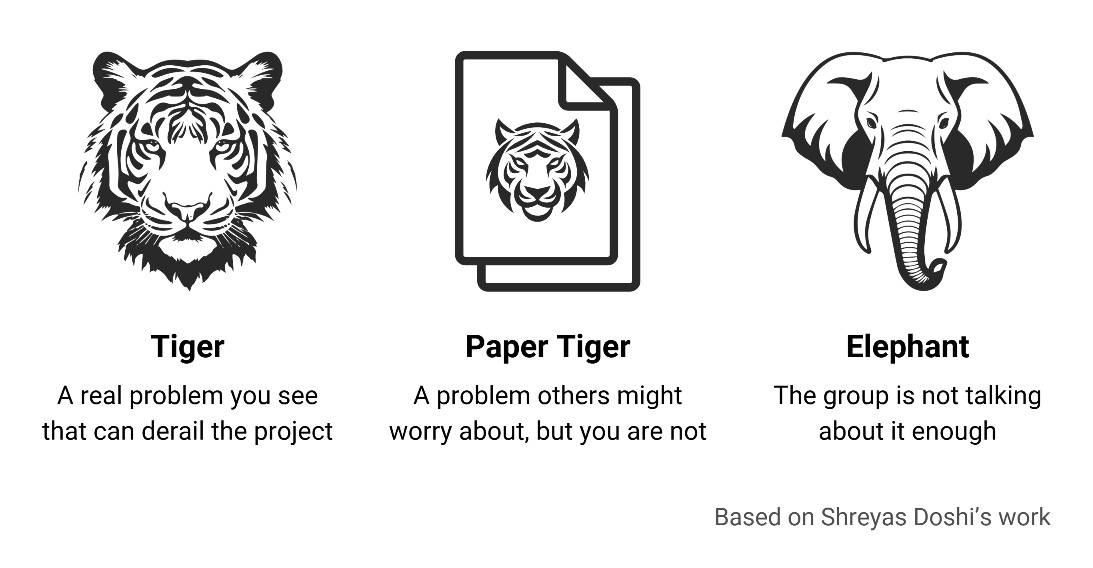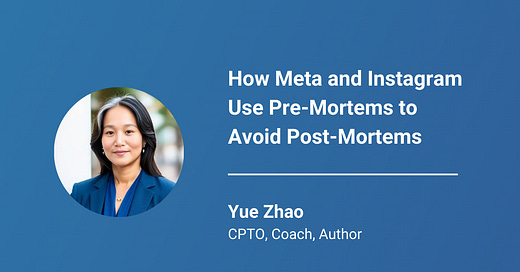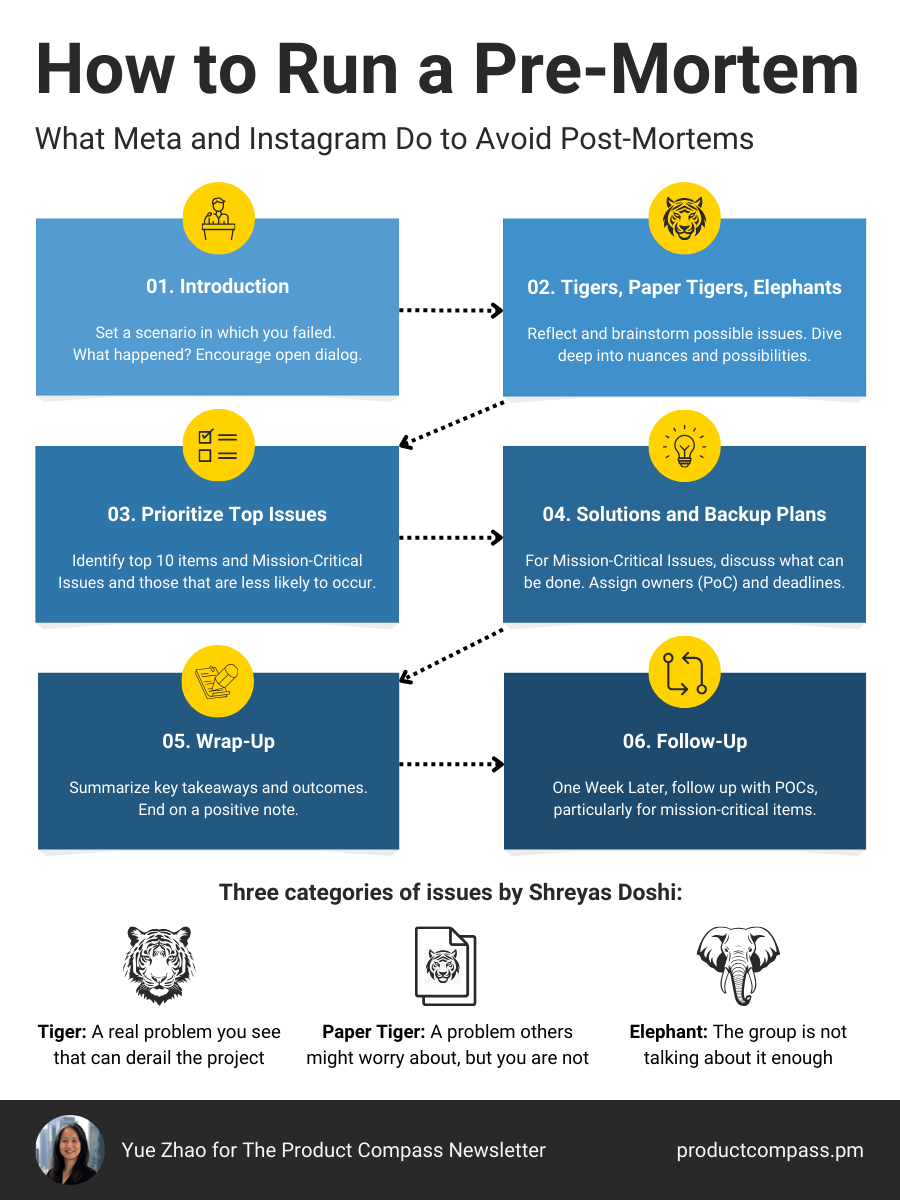How Meta and Instagram Use Pre-Mortems to Avoid Post-Mortems
A Free Pre-Mortem Template. Tigers, Paper Tigers, and Elephants.
Hey, Paweł here. Welcome to the free edition of The Product Compass!
Every week, I share actionable insights and resources for PMs.
Consider subscribing and upgrading your account for the full experience:
Today, we’re thrilled to welcome —CPTO, Coach, and Author. In this issue, she shares her insights on pre-mortems, a fantastic technique she started using at Instagram and Meta.
Yue Zhao is a Chief Product and Technology Officer turned Coach who helps women and minority leaders break through to the C-suite. She has coached hundreds of aspiring executives since 2016, is an instructor at Reforge and Maven, and author of The Uncommon Executive: Breakthrough to the C-suite as a Minority.
Prior, Yue spent 15+ years as a product executive in Silicon Valley. She was the Chief Product and Technology Officer at Fuzzy Pet Health, PM manager at Meta and Instagram, and first PM at Thumbtack. She has also been a VC-backed founder, venture partner at LifeX Ventures, and a consultant at McKinsey and Company. Yue has an MBA from Harvard Business School and a B.S. in Biomedical Engineering from the University of California, Berkeley.
Many engineering teams run post-mortems when there is a failure or error. The team needs to come together to discuss what went wrong and how to prevent it from happening again (not to assign blame or point fingers).
But what if we could anticipate and prevent these failures before they happen? Enter the pre-mortem.
Pre-mortems are a powerful tool that the best product teams at Google, Meta, Stripe, and others use regularly to increase the probability of a successful product launch and avoid difficult-to-recover failures.
In this post, I'll share how pre-mortems can benefit your team and provide actionable steps to run an effective session.
1. What Is a Pre-Mortem?
The goal of the pre-mortem meeting is to prevent the problems that cause a post-mortem meeting from happening.
At the pre-mortem meeting, everyone is encouraged to voice their concerns and fears about an upcoming product launch, new strategic direction, or newly recommended process. It allows the team working on the project to think through risks, critical junctures, and concerns and address potential issues.
Pre-mortems are essential for product development teams to increase the probability of a successful product launch and avoid difficult-to-recover failures.
2. Pre-Mortems as Valuable Alignment Forums
At the beginning of a project, there are product reviews that lead to project kick-off meetings. Notes are shared, and decisions are made. Through these forums, the PM aligns various functions on the Why, What, and How behind a project. Then, in the build phase, there’s often a core team working heads down against a timeline.
As a project progresses, the original plan will change based on new ideas, engineering challenges, or changing market conditions. New decisions are made, but often, for the sake of speed, they are not completely thought through or communicated across all functions.
This is where having a pre-mortem before launch (or at various important checkpoints of a larger project) can be super valuable.
Research conducted in 1989 (University of Colorado) found that prospective hindsight—imagining that an event has already occurred increases the ability to correctly identify reasons for future outcomes by 30%.
Pre-mortems also allow all team members and stakeholders involved in a project to air their concerns, calm their anxieties, and jointly prepare for a big launch. Often, engineering timelines shift, and other functions like sales & marketing, finance, policy, or legal don’t stay up to date on the changes, leaving them rushing for a launch or finding out about it afterward through a negative event.
Running a pre-mortem is a great way to tell everyone: "Hey, we're about ready to go—any last checks we should run?"
3. When to Run Pre-Mortems
When post-mortems are done well, they are great for anticipating issues that might come up, allowing the team to have a more thought-through plan. It also leaves room to discuss hesitations and concerns that people may not feel comfortable raising in more “regular” forums like product reviews or team meetings.
Pre-mortems are most effective when conducted:
Before Large Product Reviews: To anticipate issues and have a well-thought-out plan.
At Critical Decision Points: When pivotal choices could significantly impact the project.
A Few Weeks Before Launch: To catch any last-minute concerns and make necessary adjustments.
When Team Collaboration Feels Disconnected: To realign the team and address underlying issues.
4. How to Run a Pre-Mortem
Facilitate the discussion to identify Tigers, Paper Tigers, and Elephants
For the pre-mortem to be successful, it’s important to ensure representation across multiple functions for different perspectives. In addition to the usual suspects in engineering, PM, and design, consider inviting colleagues in data science, marketing, legal, finance, policy & privacy, and customer support. You could even run multiple sessions if the participant list becomes too large.
The facilitator (usually a PM or engineering lead) kicks off the pre-mortem meeting with a simple prompt: It is X days after launch. The project has failed. What are the reasons the project has failed?
The attendees then write down plausible hypothetical reasons why the project might have failed. The goal is to get creative, and there are no bad or ridiculous ideas.
Often, people fear being “too negative,” bringing up a “dumb idea,” or stepping on other people’s toes. To add psychological safety, I also like to prompt three categories of reasons by Shreyas Doshi: Tiger, Paper Tiger, and Elephant:
A Tiger is a real problem you see that can derail the project.
A Paper Tiger is a problem you think others might worry about, but you are not. This is often something you are working on or are very close to, so you understand why it might not be a Tiger.
An Elephant is something you are not sure is a problem, but you’re worried that the group is not talking about it enough. This is often something you are not working closely with but can imagine to be a potential issue.

Once people have written their reasons (Tigers, Paper Tigers, Elephants), the facilitator will prompt them to share around the room to create a list of reasons the project could fail (here are three templates to capture the discussion: Shreyas's coda template, Notion template, and Atlassian template).
I prefer to pick a random team member to go first and then move clockwise around the room – a process that avoids the louder or more senior people in the room getting priority. I also ask others to call if they have similar reasons or variations. Another facilitation method is to have everyone write on Post-it notes, and then, together on a whiteboard, group the Post-it notes and discuss themes. The facilitator's job here is to get ALL THE REASONs out on the table without getting stuck into discussion or debate too early.
Develop solutions and backup plans
Once the major themes and issues are on the table, the group will discuss which ones are Tigers and what next steps are required to address them. I prefer to start the discussion with the Paper Tigers. Often, one person’s Tiger is another person’s Paper Tiger. For example, an engineer may explain why reliability is not a concern, and a lawyer might explain why a certain privacy concern is not a problem. This shortcuts a lot of the plausible issues quickly and establishes each person’s credibility and value at the table.
Then, I move on to the bigger Tigers – ones that multiple people have raised. Here, the goal is to refine the shape of the Tiger as a group, ensuring everyone’s input and concerns are heard, and then find an owner for the Tiger to finalize an action plan. I’ve been doing pre-mortems with various sizes and caliber of teams for over 15 years now, and usually, it’s not a great use of time to get into the details of a specific plan in the pre-mortem meeting itself.
Sometimes, finding the owner is quick—someone will say, “This is in my area of work; I will take on this Tiger and come back to the group with the action plan and next steps.” Sometimes, the Tiger exists because it falls between ownership lines. In this scenario, it’s often best to assign a tentative owner at the meeting, whose next step is to find the best owner for the Tiger.
Finally, it’s time for the Elephants in the room. Similar to Paper Tigers, these are usually a result of undercommunication. However, Elephants are important because they allow people to “be dumb” and raise “dumb questions.”
When someone leans into their vulnerability to speak about something they fear, and the group treats the concern with seriousness and openness, it helps open up a deeper level of communication. Closing the session with Elephants builds bonds and creates psychological safety that will carry beyond the meeting.
As the meeting goes on, the facilitator will build a list of concerns (Tigers) that must be addressed. It’s helpful to sort them into:
Launch-blocking: Issues that must be resolved before the launch.
Fast-follow: Items to address in the next iteration.
Track: Concerns to monitor and assess if they become more significant.
Launch-blocking Tigers should be assigned owners to address the issue and a rough estimate of the time needed. The team may consider a follow-up conversation if many concerns need more time or if there is high uncertainty about how to resolve the launch-blocking concern.
Wrap-up
Conclude the meeting by summarizing the key takeaways and ensuring everyone is aligned on the next steps. Recap the primary risks identified—Tigers, Paper Tigers, and Elephants—and the agreed-upon action plans. Clearly outline action items, specifying responsible individuals (POCs) and timelines for implementation. Express appreciation for everyone's contributions and time commitment.
End on a positive note, reinforcing confidence in the team's ability to execute the project successfully. Consider planning a launch celebration to build excitement!
5. After the Pre-Mortem
Following the pre-mortem, it's crucial to maintain momentum and ensure that the action plans are implemented effectively. The facilitator should coordinate follow-up activities and keep the team aligned.
Action Plan Implementation: Follow up with the Tigers' owners (mission-critical issues) to ensure progress on their action plans.
Communicate Outcomes: To maintain transparency, share the meeting notes, identified risks, and action plans with the broader team. This allows team members who did not attend to contribute additional failure scenarios or see that their concerns have been acknowledged.
Ongoing Monitoring: Regularly check in on action items and adjust plans as needed. Set up periodic updates to track progress and address any emerging issues.
By sharing the discussion widely, the terminology of Tigers, Paper Tigers, and Elephants can become part of regular team lingo. This fosters a culture where members continually think of additional risks and feel comfortable discussing them openly.
6. A Free Pre-Mortem Template by Jue Zhao
Below, you can download a free detailed template with all the steps (Google Doc). Use File > Download to make a copy:
7. Benefits of Running Pre-Mortems
Pre-mortem meetings can be very cathartic (and is one of my favorite meetings!). Often, people go into it with anxiety and frowns and leave the meeting with optimism, newly built relationships, and renewed confidence in the path ahead.
In my time at Instagram and Meta, pre-mortems have:
Prevented launch conflicts with other teams.
Improved PR messaging.
Uncovered scaling issues.
Accelerated launch timelines (We’re ready! Let’s gooo!).
The concepts of Tigers, Paper Tigers, and Elephants often become part of the team's regular vocabulary, fostering continuous risk awareness and open communication.
Conclusion
Pre-mortems are a proactive approach to identifying and mitigating potential project failures. By fostering open dialogue and collaborative problem-solving, teams can align more effectively, anticipate challenges, and increase their chances of a successful launch.
I encourage you to incorporate pre-mortems into your project planning process to experience these benefits firsthand.
Where to Find Yue Zhao
Make sure to subscribe to my newsletter, The Uncommon Executive:
You can also follow me on LinkedIn or learn about coaching with me at www.yuezhao.coach.
Take care, Yue
Thanks for reading The Product Compass!
Paweł here again. It's great to learn and grow together.
Here are a few other posts you might have previously missed:
Consider subscribing and upgrading your account, if you haven’t already, for the full experience:
Have a great weekend and a productive week ahead,
Paweł
P.S. Need a Christmas gift idea? 🌟🎁









This is great and extremely helpful!